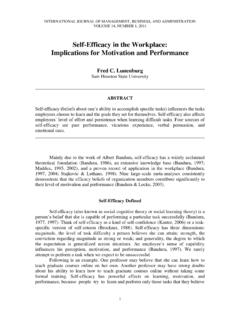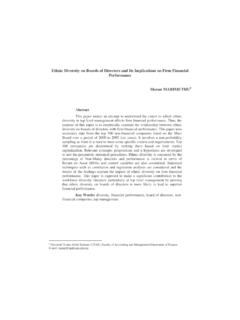Transcription of Examination of The Biophilia Hypothesis and its ...
1 Douglas Radmore is an undergraduate student of Psychology and Criminology and the University of Brighton, England. Having Examination of The specialised in ecopsychology and therapeutic relationships his works focuses both on the Biophilia Hypothesis and its implications mental health implications of ecopsychology as well as environmental activism and conservation psychology. To contact: for Mental Health Douglas Radmore The Biophilia Hypothesis was originally referred to (Wilson, 1984) as an innate tendency to focus on life and lifelike processes', meaning that we gain the most satisfaction from processes that mimic the nature of life on many levels, be they cognitive or emotional. Since then, the Biophilia Hypothesis has been applied to many areas of life, including mental health (White & Heerwagen, 2013). This is largely due to refinements in the theory by people like Wilson & Kellert (1993) where Wilson stated that Biophilia was a complex set of learned behaviours and processes based on our connection to nature.
2 These learnings are split into Biophilia , which are positive learnings and approach' behaviours and biophobia which are negative learnings with avoid' behaviours (Ulrich, 1993). Wilson claims the opposite of writers like Fisher (2003) who believe our connection to nature is replaced by technology, but argues that our biophilic feelings atrophy and are integrated into our cultural systems as exemplified by zoos and nature based attractions. In terms of its application to mental health, the ability to live, think and learn healthily and live with ones emotions and the reactions of others in a consistent manner (Herman et al, 2001), in contemporary society is clear; biophilic and biophobic tendencies are a marker of culture (Wilson, 1993) and if we take the assumptions made by various commentators (Foucault, 1964; Horwitz, 2002; Rind & Yuill, 2012) that mental health is a product of its culture, the connection is clearer still.
3 The problems of mental health are shown to be increasing the world over (Desjarlais et al, 1995), whilst Biophilia as a Hypothesis can answer this to a degree, it provides many other answers, namely to do with the origin of many of these conditions that we are experiencing. Fears and phobias are a cornerstone of mental health (Agras, Sylvester & Oliveau, 1969) forming the root of many more severe mental health problems (Horwitz, 2002) and altering the way we go about our lives (Kessler, 2003). Those associated with animals and the environment are prevalent amongst them, with 40% of major phobia groups being based on environmental issues like tunnels or the ocean, or animal issues such as sharks or snakes, according to Torgersen (1979). These phobias shape the way we live our lives and if they become more extreme can severely inhibit how much living we actually do (Kessler, 2003).
4 Seligman's work (1970) suggests that we have an innate fear of landscapes and environs and that the most obvious of these is heights and high up places. This is because they have a relevant level of risk to humans (Ulrich, 1993) in that we die if we fall from them, but that the phobia of heights (acrophobia) is becoming harder to realise as the world becomes more and more industrialised (Ulrich, 1993). Other phobias and the behaviours related to environmental factors can be explained similarly such as agoraphobia (fear of open spaces) as a fear of being hunted easily (Nesse, 1987) and thalassaphobia (fear of the ocean, as mentioned above) has been linked to both agoraphobic conditions and acrophobic stimuli, and symptoms such as shallow breathing and limb freezing (Saeed & Bajwa, 2012) similar to that of panic attacks and can be treated in similar ways.
5 We can see that these are to at least some degree innate and not learned as there are more deaths per year from automobile incidents than falling from high places and they are more visible to us, yet we do not have a strong fear of cars at birth (White & Heerwagen, 2013). Fears associated with specific animals are prevalent in the human psyche, with Wilson (1984) noting one in particular; snakes, or as he puts it the serpent'. Wilson describes the hyper contextualised version of a snake, that is more evil' than any snake in reality could be, and argues that it is a result of snakes being a predatory influence in early hominids', and as such as evolutionarily programmed to cause us fear. The point can however be made that we are no longer hunter-gatherers so why do we still fear snakes? (Ulrich, 1993). Cook & Minkea's 1989 study of fear in rhesus monkeys holds some answers; lab bred na ve animals held no fear for reptiles until shown wild monkeys expressing intense fear of snakes and lizards, and as such the lab bred monkeys even feared toys representing snakes.
6 This shows that whilst we have a natural ingrained tendency toward certain phobias (Cook & Minkea, 1989) the fears that we hold are also kept in place through our cultural make up and learned reactions from peers, the same way they would have been transmitted in hunter-gatherer societies (Lundberg, 2013), to this end it can be seen that biophobia in relation to predatory animals, including the fight or flight complex (Dunn, 2010) is both evolutionary and cultural (Lundberg, 2013). This said, fear of small animals like insects is more common than that of large ones, with arachnophobia effecting approximately 6% of the human population (Schmitt & Muri, 2009), and presents us with a different set of anxiety responses (Webb & Davey, 1992). These types of phobias are based on disgust sensitivity (Phillips et al, 1998), a specific difficulty in regulating disgust (Cisler, Olatunji & Lohr, 2009), and are the basis of most anxiety conditions like social phobias or obsessive compulsive complaints (Phillips, 1998) sharing symptoms with this level of biophobia.
7 Rozin &. Fallon (1987) argue that disgust was an evolutionary avoidance reaction of preventing humans from ingestion what they termed negative pathogens', like disease. Rozin and Fallon argue that we have built our culture around this avoidance reaction to enforce them actively, shown through what we choose to eat and the way we deal with hygiene and animals (Haidt et al, 1997). The relevance to biophobia of disgust is that disgust is almost always animal based (Rozin & Fallon, 1987) with the perceived slime' of snakes or the crawling of bugs provoking avoidance reactions as they could denote the previously mentioned negative pathogens, which is why faecal matter of both animals and humans provokes the strongest disgust reaction (Rozin & Fallon, 1987). As such, Ulrich (1993) states we have the strongest reaction to the serpent' as it provokes both a predatory fear response and disgust response, making its biophobic level far greater than many other animals.
8 Biophobias relevance to modern life is twofold, firstly as Lundberg (2013) shows we have formed our culture around phobias from both animals and environmental factors that have shaped the way we react to stimuli of contemporary society (Serpell, 2004) that wouldn't be relevant in the original evolutionary setting. The avoidance reaction is key to phobias and is seen on a macro scale, with prevalence of pest control and on a micro scale with people developing conditions like obsessive compulsive cleaning habits (Matchett & Davey, 1991). This said humans are demonstrably shown to be sensation seeking (Zuckerman, 1979) even those who are neophobic (scared of new experiences, Haidt, McCauley & Rozin, 1993) and as such we try to defy our inbuilt biophobia and this in turn explains the nature of high rise cityscapes or choosing to live by the sea (Haidt et al, 1997).
9 It is however argued that as we lose the biophilic part of our evolutionary psychology, we begin to experience more biophobias, as we become disconnected from their source (Wilson, 1993) as they may become watered down' through our expanding population. In contrast to the concept of biophobia, is Biophilia and its positivity. White & Keerwagen (2013). state that less is written about these positive aspects of Biophilia because the payoffs are not as dire, as in if we fail to acknowledge a biophobic response, we are in danger of dying. This is combined with the problem that much of ecopsychology faces in general that a wealth of its evidence, especially from treatment programmes has been anecdotal rather than empirical (Beyerstein, 1997) as Fisher (2003). and others like him argue it should be. Biophilia has two main implications for mental health, the first of these being treatments of both biophobia based conditions, but also of other mental health issues (Ulrich et al, 1991).
10 There are a number of writers who claim the effectiveness of biophilic elements in treatment (Melson & Fine, 2010) such as plants added to settings or animal integration, often at the same time. For this particular application of the Biophilia Hypothesis there is an effort to make evidence empirical, with well documented studies taking place as opposed to previously mentioned anecdotal evidence (Fine, 2010). A primary example of this is Melson's 2001 study into dearousal' of stress and anxiety patients, his study used therapeutic interviews combined with playing with or watching animals. Melson found that the animal influences allowed for the levels of stress of anxiety to decrease in the individuals, whilst also allowing them to learn positive nurturing techniques to apply to themselves as calming mechanisms (Melson, 2001), and suggested that this is at least in part to do with our affiliation to positive animal influences (such as using dogs for hunting) in our biophilic past.




